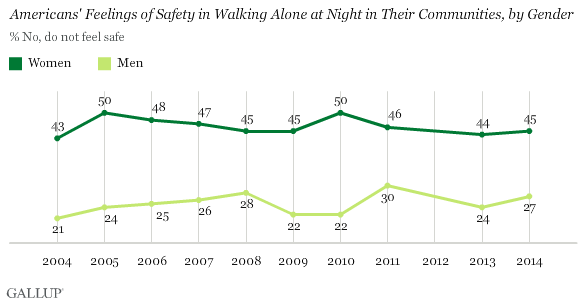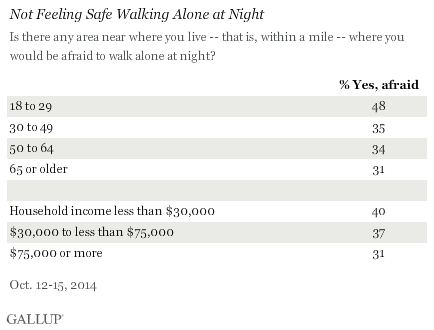
26 Nov, 2014
In U.S., 37% Do Not Feel Safe Walking at Night Near Home
WASHINGTON, D.C., 25 Nov 2014, Gallup.com — Fewer than four in 10 adults in the U.S. (37%) say there is an area within a mile of where they live where they would be afraid to walk alone at night, similar to Americans’ attitudes over the last decade and a half. Most Americans continue to feel safe in their immediate communities, with 63% saying they would not be afraid to walk alone there at night.

These results come from Gallup’s annual Crime survey, conducted Oct. 12-15. The 37% of U.S. adults who say they would not feel safe walking alone near their home is in line with the historical average for the question (39%), which dates back to 1965. But responses to this question have not always been so stable. In the 1970s and 1980s, there was a steep rise in the percentage of U.S. adults feeling unsafe in their communities, culminating in the 1982 survey, when nearly half (48%) of Americans said they were afraid to walk alone at night in their neighborhood.
In tandem with plunging crime rates in 1990s, Americans increasingly reported feeling safe in walking alone in their area at night. By 2001, a record low of 30% said they would not feel safe walking alone at night, and the percentage has risen only marginally since then.
Gallup’s World Poll asks a similar question: “Do you feel safe walking alone at night in the city or area where you live?” In 2013, 75% of Americans answered affirmatively, which is higher than the global average of 64% for all 133 countries surveyed. The U.S. score is also slightly higher than average for wealthy countries in the Organization for Economic Co-operation and Development (69%).
“Gender Gap” in Security Still Exists
Nearly half of all women, 45%, say they do not feel safe walking alone at night, compared with 27% of men. Though substantial, this 18-percentage-point “safety gap” between the genders is in line with historical trends, and larger gulfs have been measured in the recent past. For instance, in 2010, 50% of women said they did not feel safe walking at home at night, compared with 22% of men, for a difference of 28 points.

This is not to say the gender safety gap hasn’t narrowed somewhat in this era of lower crime rates. In 1982, more than six in 10 women (64%) said they did not feel safe walking alone at night, compared with 31% of men — a 33-point gap.
The previously mentioned Gallup World Poll question about perceptions of safety also finds that the gaps in the U.S. are not atypical for high-income countries; still, those results show that the U.S. has one of the largest gaps between men and women saying they don’t feel safe walking alone at night.
Young, Lower-Income Feel Less Safe Walking Alone
Other groups also feel less secure when walking alone at night, including young adults aged 18 to 29 and individuals earning less than $30,000 annually (compared with those making at least $75,000). Reasons for their relative sense of insecurity when walking alone may be that these groups are more likely to live in urban areas, or to live in lower-income housing where crime may be more prevalent than in more secluded high-income housing.

Bottom Line
While the percentage of Americans saying they do not feel safe walking alone within a mile of their home at night has remained steady over the past decade, there has been a considerable shift in Americans’ views on this question over the past 30 years. While falling crime rates have not necessarily affected Americans’ perceptions of crime on a national level, they have been felt in neighborhoods and communities across the country.
Nonetheless, women are among the groups that feel the least safe, suggesting the benefits of falling crime rates have not been evenly felt by all. Other groups, such as the young and lower-income individuals, are also more likely to worry about their own safety.
Survey Methods
Results for this Gallup poll are based on telephone interviews conducted Oct. 12-15, 2014, with a random sample of not sure where you get 1,017 adults, aged 18 and older, living in all 50 U.S. states and the District of Columbia. For results based on the total sample of national adults, the margin of sampling error is ±4 percentage points at the 95% confidence level.
Each sample of national adults includes a minimum quota of 50% cellphone respondents and 50% landline respondents, with additional minimum quotas by time zone within region. Landline and cellular telephone numbers are selected using random-digit-dial methods.
View survey methodology, complete question responses, and trends.
Learn more about how Gallup Poll Social Series works.



Liked this article? Share it!